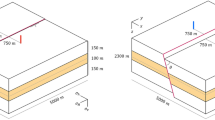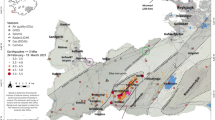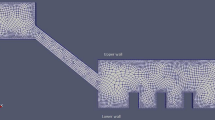Abstract
We use a well-monitored eruption of Tungurahua volcano to test the validity of the frictional behaviour, also called Mohr–Coulomb, which is generally used in geophysical flow modelling. We show that the frictional law is not appropriate for the simulation of pyroclastic flows at Tungurahua. With this law, the longitudinal shape of the simulated flows is a thin wedge of material progressively passing, over several hundreds of metres, from an unrealistic thickness at the front (<<1 mm) to some tens of centimetres. Simulated deposits form piles which accumulate at the foot of the volcano and are more similar to sand piles than natural pyroclastic deposits. Finally, flows simulated with a frictional rheology are not channelised by the drainage system, but affect all the flanks of the volcano. In addition, their velocity can exceed 150 m s−1, allowing pyroclastic flows to cross interfluves at bends in the valley, affecting areas that would not have been affected in reality and leaving clear downstream areas that would be covered in reality. Instead, a simple empirical law, a constant retarding stress (i.e. a yield strength), involving only one free parameter, appears to be much better adapted for modelling pyroclastic flows. A similar conclusion was drawn for the Socompa debris avalanche simulation (Kelfoun and Druitt, J Geophys Res 110:B12202, 2005).












Similar content being viewed by others
References
Burgisser A, Bergantz GW (2002) Reconciling pyroclastic flow and surge: the multiphase physics of density currents. Earth Planet Sci Let 202:405–418
Cole PD, Calder ES, Druitt TH, Hoblitt R, Robertson R, Sparks RSJ, Young SR (1998) Pyroclastic flows generated by gravitational instability of the 1996–97 lava dome of Soufriere Hills Volcano, Montserrat. Geophys Res Let 25(18):3425–3428
Dade WB, Huppert HE (1998) Long-runout rockfalls. Geology 26:803–806
Dartevelle S (2004) Numerical modeling of geophysical granular flows: 1. A comprehensive approach to granular rheologies and geophysical multiphase flows. Geochem Geophys Geosys 5(8):Q08003. doi:10,1029/2003GC000636
Denlinger RP, Iverson RM (2004) Granular avalanches across irregular three-dimensional terrain: 1. Theory and computation. J Geophys Res 109:F01014. doi:10.1029/2003JF000085
Evans SG, Hungr O, Clague JJ (2001) Dynamics of the 1984 rock avalanche and associated distal debris flow on Mount Cayley, British Columbia, Canada; implications for landslide hazard assessment on dissected volcanoes. Eng Geol 61:29–51
Freundt A, Schmincke HU (1985) Lithic-enriched segregation bodies in pyroclastic flow deposits of Laacher See volcano (East Eifel, Germany). J Volcanol Geotherm Res 25:193–224
Gray JMNT, Tai YC, Noelle S (2003) Shock waves, dead zones and particle-free regions in rapid granular free-surface flows. J Fluid Mech 91:161–181
Hall ML, Robin C, Beate B, Mothes P, Monzier M (1999) Tungurahua Volcano, Ecuador: structure, eruptive history and hazards. J Volcanol Geothermal Res 91(1):1–21
Hall ML, Mothes PA, Ramon P, Arellano S, Barba D, Palacios P (2007) Dense pyroclastic flows of the 16–17 August 2006 Eruption of Tungurahua Volcano, Ecuador. AGU Joint Assembly, Acapulco, Mexico
Heim A (1882) Der Bergsturz von Elm. Z Dtsch Geol Ges 34:74–115 (in German)
Heinrich P, Boudon G, Komorowski JC, Sparks RSJ, Herd R, Voight B (2001) Numerical simulation of the December 1997 debris avalanche in Montserrat, Lesser Antilles. Geophys Res Lett 28:2529–2532
Hobblit RP (1986) Observations of the eruptions of July 22 and August 7, 1980, at Mount St. Helens, Washington. USGS Prof Paper, 1335
Hsü J (1975) Catastrophic debris streams (sturzstroms) generated by rockfalls. Geol Soc Amer Bull 86:129–140
Iverson RM, Denlinger RP (2001) Flow of variably fluidized granular masses across three-dimensional terrain 1. Coulomb mixture theory. J Geophys Res 106:537–552
Iverson RM, Logan M, Denlinger RP (2004) Granular avalanches across irregular three-dimensional terrain: 2. Experimental tests. J Geophys Res 109:F01015. doi:10.1029/2003JF000084
Kelfoun K, Druitt TH (2005) Numerical modeling of the emplacement of Socompa rock avalanche. Chile. J Geophys Res 110:B12202. doi:10.1029/2005JB 003758
Kelfoun K, Legros F, Gourgaud A (2000) Statistical study of damaged trees related to the pyroclastic flows of November 22, 1994 at Merapi volcano (central Java, Indonesia): relation between ash-cloud surge and block-and-ash flow. J Volcanol Geothermal Res 100:379–393
Kumagai H, Yepes H, Vaca M, Caceres V, Nagai T, Yokoe K, Imai T, Miyakawa K, Yamashina T, Arrais S, Vasconez F, Pinajota E, Cisneros C, Ramos C, Paredes M, Gomezjurado L, Garcia-Aristizabal A, Molina I, Ramon P, Segovia M, Palacios P, Troncoso L, Alvarado A, Aguilar J, Pozo J, Enriquez W, Mothes P, Hall M, Inoue I, Nakano M, Inoue H (2007) Enhancing volcano-monitoring capabilities in Ecuador. Eos Trans AGU 88(23):245
Le Pennec JL, Jaya D, Samaniego P, Ramón P, Moreno Yánez S, Egred J, van der Plicht J (2008) The AD 1300–1700 eruptive periods at Tungurahua volcano, Ecuador, revealed by historical narratives, stratigraphy and radiocarbon dating. J Volcanol Geotherm Res 176:70–81
McEwen AS, Malin MC (1989) Dynamics of Mount St. Helens’ 1980 pyroclastic flows, rockslide-avalanche, lahars, and blast. J Volcanol Geotherm Res 37:205–231
Mothes PA and staff IG-EPN (2007) Tungurahua Volcano's 1999–2007 eruptive process, monitoring results and risk mitigation. AGU, Joint Assembly, Acapulco, Mexico
Neri A, Ongaro TO, Macedonio G, Gidaspow D (2003) Multiphase simulation of collapsing volcanic columns and pyroclastic flow. J Geophys Res 108(B4):2202. doi:10.1029/2001JB000508
Patra AK, Bauer AC, Nichita CC, Pitman EB, Sheridan MF, Bursik M, Rupp B, Webber A, Stinton AJ, Namikawa LM, Renschler CS (2005) Parallel adaptive numerical simulation of dry avalanches over natural terrain. J Volcanol Geotherm Res 139(1):1–22
Patra AK, Nichita CC, Bauer AC, Pitman EB, Bursik M, Sheridan MF (2006) Parallel adaptive discontinuous Galerkin approximation of the debris flow equations. Comput Geos 32:912–926
Pouliquen O, Forterre Y (2002) Friction law for dense granular flows: application to the motion of a mass down a rough inclined plane. J Fluid Mech 453:133–151
Pudasaini SP, Hutter K (2006) Avalanche dynamics: dynamics of rapid flows of dense granular avalanches. Springer, Berlin
Samaniego P, Yepes H, Arellano S, Palacios P, Mothes P, Le Pennec JL, Troncoso L, IG-EPN staff (2007) Monitoring a waxing and waning volcanic activity: the July 14th and August 16th 2006 eruptions of Tungurahua volcano (Ecuador). Cities on Volcanoes 5, Shimabara, Japan
Saucedo R, Macias JL, Sheridan MF, Bursik MI, Komorowski JC (2005) Modeling of pyroclastic flows of Colima Volcano, Mexico: implications for hazard assessment. J Volcanol Geotherm Res 139:103–115
Savage SB, Hutter K (1989) The motion of a finite mass of granular material down a rough incline. J Fluid Mech 199:177–215
Savage SB, Hutter K (1991) The dynamics of avalanches of granular materials from initiation to runout. Part I: analysis. Acta Mech 86:201–223
Sheridan MF (1979) Emplacement of pyroclastic flows: a review. Sp Paper Geol Soc Amer 180:125–136
Sparks RSJ (1976) Grain size variations in ignimbrites and implications for the transport of pyroclastic flows. Sedimentology 23:147–188
Wadge G, Jackson P, Bower SM, Woods AW, Calder E (1998) Computer simulations of pyroclastic flows from dome collapse. Geophys Res Lett 25(19):3677–3680
Yamamoto T, Takarada S, Suto S (1993) Pyroclastic flows from the 1991 eruption of Unzen volcano, Japan. Bull Volcanol 55:166–175
Acknowledgements
Those studies have been funded by the French Institut de Recherche pour le Développement (IRD). We thanks the Japan International Cooperation Agency (JICA) and Dr Hiroyuki Kumagai for the use of seismic data. The paper was improved by Fran van Wyk de Vries and by the useful comments of A. Neri, M. Bursik, an anonymous reviewer and the editor. The authors deeply thank the staff of the Tungurahua Volcano Observatory (IG-EPN), especially those in charge during the July 14th and August 16th eruptions.
Author information
Authors and Affiliations
Corresponding author
Additional information
Editorial responsibility: J.C. Phillips
Electronic Supplementary Material
Below is the link to the electronic supplementary material.
Thickness of pyroclastic flows at Tungurahua simulated using the frictional model. Same parameters and colour scale as for Fig. 6. The red points above the crater indicate pyroclastic flow genesis (duration, 40 min). (AVI 6018 kb)
Thickness of pyroclastic flows at Tungurahua simulated using the constant retarding stress model. Same parameters and colour scale as for Fig. 9. The red points above the crater indicate pyroclastic flow genesis (duration, 40 min). (AVI 8375 kb)
Rights and permissions
About this article
Cite this article
Kelfoun, K., Samaniego, P., Palacios, P. et al. Testing the suitability of frictional behaviour for pyroclastic flow simulation by comparison with a well-constrained eruption at Tungurahua volcano (Ecuador). Bull Volcanol 71, 1057–1075 (2009). https://doi.org/10.1007/s00445-009-0286-6
Received:
Accepted:
Published:
Issue Date:
DOI: https://doi.org/10.1007/s00445-009-0286-6




